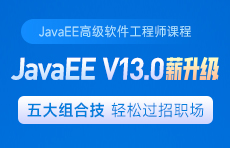Spring框架中的单例Beans是线程安全的么?
更新时间:2023年05月03日09时18分 来源:传智教育 浏览次数:

在Spring框架中,单例Beans默认是线程安全的。
当你在Spring框架中声明一个单例Bean并配置为默认的单例作用域时,Spring会确保对该Bean的并发访问是线程安全的。以下是一个简单的代码演示:
假设我们有一个名为 SingletonBean 的单例 Bean 类,其中包含一个可变的状态 counter,并提供了一个线程安全的增加计数器的方法:
public class SingletonBean {
private int counter = 0;
public synchronized void incrementCounter() {
counter++;
}
public int getCounter() {
return counter;
}
}
在上述示例中,我们使用了synchronized关键字修饰了incrementCounter()方法,确保了对计数器的增加操作是原子性的,并且在多线程环境下是线程安全的。

接下来,在 Spring 配置文件中声明 SingletonBean 作为单例 Bean:
<bean id="singletonBean" class="com.example.SingletonBean" scope="singleton" />
现在,我们可以在多个线程中使用SingletonBean并调用增加计数器的方法:
public class MainClass {
public static void main(String[] args) throws InterruptedException {
ApplicationContext context = new ClassPathXmlApplicationContext("applicationContext.xml");
SingletonBean bean = context.getBean("singletonBean", SingletonBean.class);
// 创建两个线程,同时对计数器进行增加操作
Thread thread1 = new Thread(() -> {
for (int i = 0; i < 1000; i++) {
bean.incrementCounter();
}
});
Thread thread2 = new Thread(() -> {
for (int i = 0; i < 1000; i++) {
bean.incrementCounter();
}
});
thread1.start();
thread2.start();
thread1.join();
thread2.join();
System.out.println("Counter value: " + bean.getCounter());
}
}
在上述代码中,我们创建了两个线程分别对计数器进行增加操作,每个线程增加计数器 1000 次。通过调用 join() 方法等待两个线程执行完毕,然后输出最终的计数器值。
由于 incrementCounter() 方法被修饰为 synchronized,在多线程环境下,对计数器的增加操作是同步的,因此最终输出的计数器值应为 2000,证明了单例 Bean 的线程安全性。
需要注意的是,虽然Spring保证了对单例Bean的并发访问的线程安全性,但如果你在Bean中引入了非线程安全的外部资源或其他线程安全问题,仍然需要谨慎处理。
当多个线程同时访问单例 Bean 时,Spring 会确保线程安全性。Spring 容器会使用线程同步机制,例如使用同步块或者使用线程安全的数据结构来保证对单例 Bean 的并发访问不会引发竞态条件(race condition)或其他线程安全问题。
总结起来,Spring的单例Beans是线程安全的,但是你需要注意处理内部状态的同步问题,尤其是当涉及到可变状态时。


















 AI智能应用开发
AI智能应用开发 鸿蒙应用开发
鸿蒙应用开发 HTML&JS+前端
HTML&JS+前端 Python+大数据开发
Python+大数据开发 人工智能开发
人工智能开发 跨境电商
跨境电商 电商视觉设计
电商视觉设计 软件测试
软件测试 新媒体+短视频
新媒体+短视频 集成电路应用开发
集成电路应用开发 C/C++
C/C++ 狂野架构师
狂野架构师 IP短视频
IP短视频





















